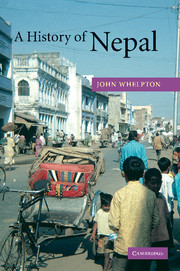Book contents
- Frontmatter
- Contents
- List of illustrations
- List of maps
- List of tables
- Key events
- Acknowledgements
- Notes on romanisation and terminology
- List of abbreviations
- Introduction
- 1 Environment, state and society in the central Himalayas to 1743
- 2 Unification and sanskritisation, 1743 – 1885
- 3 Nepal under the Shamsher Ranas, 1885 – 1951
- 4 The monarchy in ascendance: domestic politics and foreign relations, 1951 – 1991
- 5 The quest for ‘development’: economy and environment, 1951 – 1991
- 6 Lifestyles, values, identities: changes in Nepalese society, 1951 – 1991
- 7 Democracy and disillusionment: Nepal since 1991
- Genealogical tables
- Biographical notes
- Notes
- Glossary
- Bibliography
- Index
4 - The monarchy in ascendance: domestic politics and foreign relations, 1951 – 1991
Published online by Cambridge University Press: 05 June 2016
- Frontmatter
- Contents
- List of illustrations
- List of maps
- List of tables
- Key events
- Acknowledgements
- Notes on romanisation and terminology
- List of abbreviations
- Introduction
- 1 Environment, state and society in the central Himalayas to 1743
- 2 Unification and sanskritisation, 1743 – 1885
- 3 Nepal under the Shamsher Ranas, 1885 – 1951
- 4 The monarchy in ascendance: domestic politics and foreign relations, 1951 – 1991
- 5 The quest for ‘development’: economy and environment, 1951 – 1991
- 6 Lifestyles, values, identities: changes in Nepalese society, 1951 – 1991
- 7 Democracy and disillusionment: Nepal since 1991
- Genealogical tables
- Biographical notes
- Notes
- Glossary
- Bibliography
- Index
Summary
The political dynamic of the forty years following the overthrow of the Rana regime was principally the result of interaction among three forces: the monarchy, around which traditional elements, including much of the Rana family itself, were to regroup; the political parties, whose support bases were initially quite narrow; and the Indian government, ideologically sympathetic to the Nepali Congress Party, but still seeing Nepal primarily in terms of border security. During the 1950s, as has again been the case in Nepal since autumn 2002, the royal palace remained the effective centre of government, especially after King Mahendra's accession in 1955, but political parties functioned freely and everyone, including the king, at least paid lip-service to multi-party democracy. When parliamentary elections were finally held in 1959, the centre of gravity shifted briefly to the elected government but in the following year Mahendra aborted the democratic experiment and took full control of the state into his own hands. Royal dominance, clothed in the rhetoric of ‘partyless Panchayat democracy’, remained secure until Mahendra's death in 1972, buttressed by the king's ability to balance adroitly between India and China. However, his son, Birendra, who initially tried to retain the old system, faced a more difficult task. Rapid change in Nepalese society, including in particular the regime's own success in expanding education, coupled with failure to increase opportunities in line with expectations, produced growing tension. In addition, international room for manoeuvre was reduced when India confirmed its dominance in South Asia by its victory over Pakistan in 1971. Following disturbances in 1979, Birendra called a referendum on the constitution, which, thanks to the regime's grip on village Nepal, endorsed the Panchayat system. However, the results showed clearly that urban Nepal was committed to the party system and, when a dispute with India and the reverberations of the collapse of autocracies in Eastern Europe sparked protests in 1990, Birendra gave way and allowed the restoration of the multi-party system. Elections in 1991 were won by the Nepali Congress Party, which thus regained the position Birendra's father had deprived it of a generation previously.
THE FIRST MULTI-PARTY EXPERIMENT: 1951–1960
The Congress–Rana coalition was beset with difficulties from the start.
- Type
- Chapter
- Information
- A History of Nepal , pp. 86 - 121Publisher: Cambridge University PressPrint publication year: 2005



